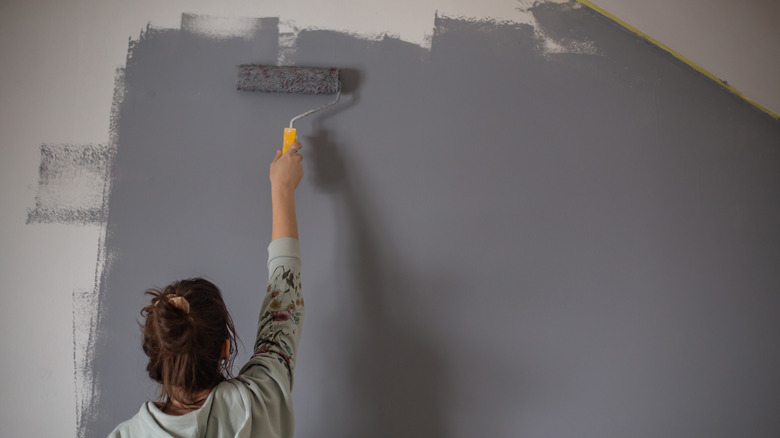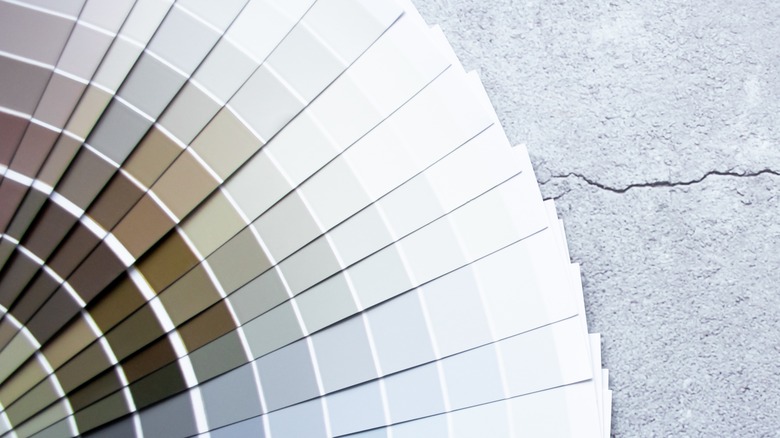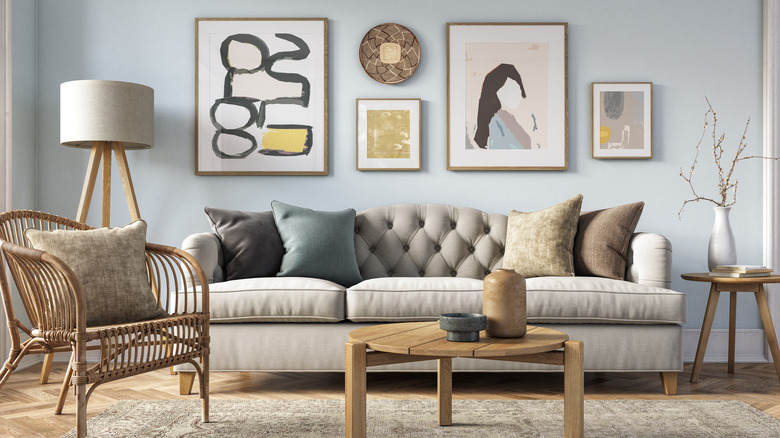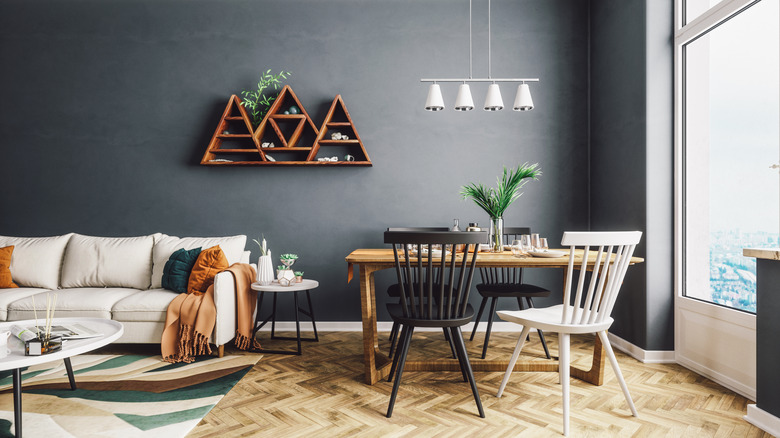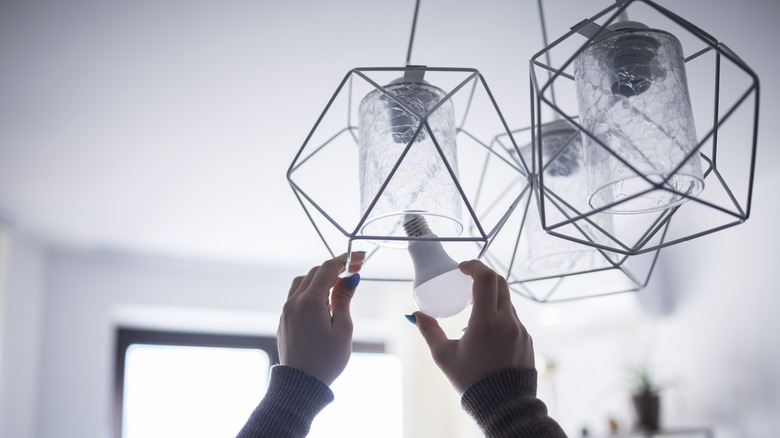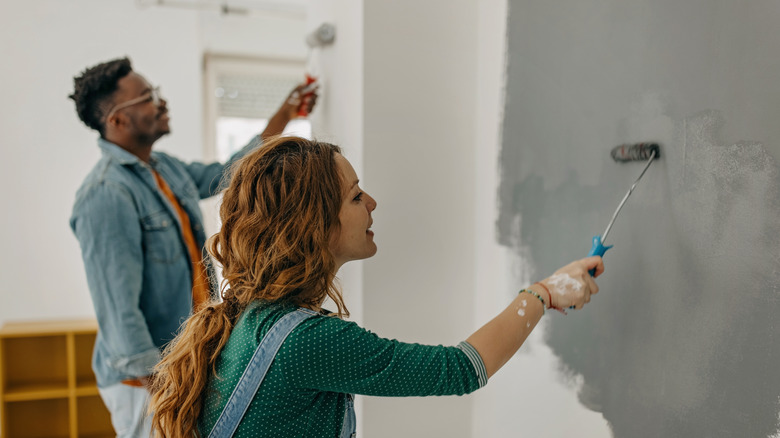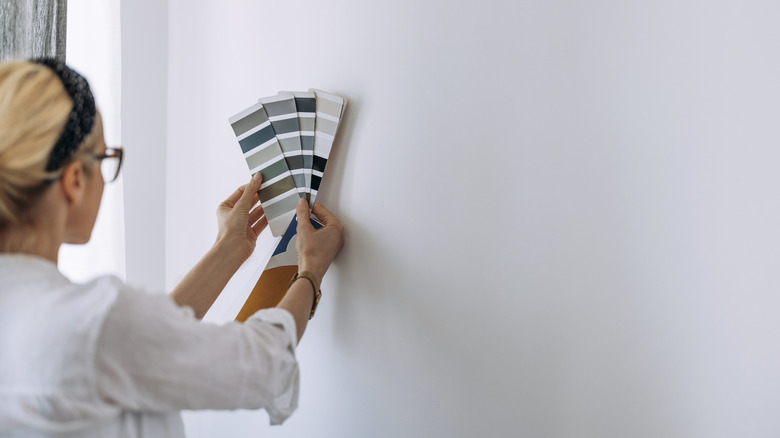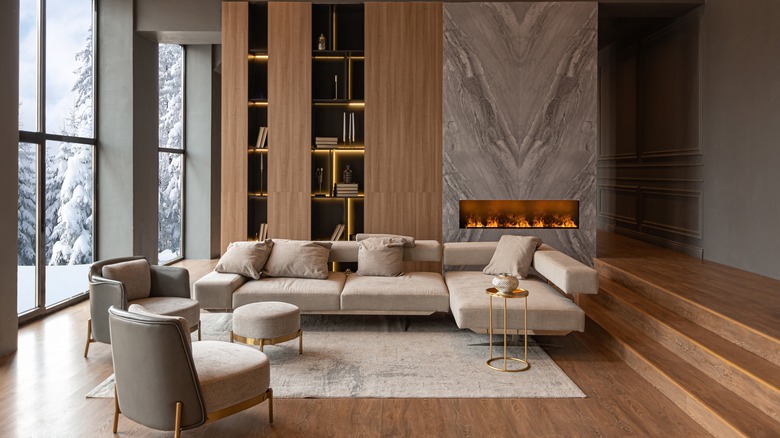Mistakes You're Making When Choosing A Gray Paint Color (And How To Do It Right)
Gray paint is one of the most popular colors for interiors. Joanna Gaines famously used plenty of gray paint in the homes on HTGV's Fixer Upper, and Sherwin Williams, a go-to paint brand for many, reports Agreeable Gray, Repose Gray, Light French Gray, and Mindful Gray to be among its top ten colors. Of Sherwin William's top 50 colors, thirteen are shades of gray. Gray mixed with beige, sometimes called "greige," has also been a big paint trend in 2023. And why wouldn't it be? It's neutral-leaning, can support all sorts of colors without seeming monotone, and works in any room in the house.
As a neutral tone, gray seems to go well with just about everything, without some of the drawbacks white may have, such as high visibility for dirt and dust. However, you may be surprised to find that there are plenty of mistakes you can still make when choosing a gray paint for your home. There are the usual pitfalls –not considering the purpose of your room when choosing the color, not matching the tone to the rest of your decor, painting too few layers or not the same amount of layers throughout the room– but so many other rules apply specifically to gray. Before you pick up the paint rollers and drop your tarps, make sure the gray you've chosen is the right one for your home.
You aren't paying attention to undertones
It can be difficult to detect a gray color's undertone in isolation. By itself, it probably looks, well, gray. While you can certainly differentiate it from other shades of gray on hand, it might be hard to pick out the notes of blue, red, or green in the gray, especially without anything to compare it to. Luckily, paint swatches are usually free, and incredibly easy to find in just about any home improvement or hardware store. These swatches will usually show the color in descending shades, so you can skip right down to the bottom to see what colors are hiding under your gray.
These undertones are usually cool or warm. Cool undertones will be blue, purple, and green, while warm will usually be red, orange, and yellow. Deciding which you want can help in your initial search for colors, but ignoring them completely can throw off the look of your room. You'd be surprised how a swatch can look plain gray, and then once you've finished painting, you see it's actually just a bit more purple than you thought it was. Don't let your eye trick you into thinking there aren't any undertones playing under the surface; use those colors to your advantage.
You haven't taken into account you have a north facing room
So... the direction your windows face out matters? Get out your compass, because yes, it definitely does. In an exclusive interview with House Digest, architectural lighting designer Natalie Anderson said, "The type of light coming in is more important to consider; if you live in North America and have a north-facing room, you won't ever get direct sun exposure in the room. You'll have consistent sky light throughout the day, but never direct sun."
Due to the bluer spectrum of sky light, your cool tones will be picked up a lot more than in another room. Anderson says that "A seemingly neutral color in a north-facing room will not look as warm as it might in another room," and that you should pick out a gray with warm undertones in these spaces to balance the light's effect out. She suggests using a paint swatch on your wall to really understand the overall look the sky light will give your gray paint. "Any warm undertone works for balance, but if you are going for a bluer look, cool undertones will be greatly enhanced in a north room."
You don't take into account your east facing windows
Having east-facing windows means you will be dealing with different tones of light throughout the day. Natalie Anderson told House Digest that "Sun rises in the east, so first thing in the morning you're going to get blasted with sun and that warm-toned light. So how do you want your room to feel in the morning? Do you want it to feel super bright in the morning, but not as much throughout the day? Because in the evening, it will be way more cool-toned, so this space may feel much darker than it will throughout other times in the day. Choose your gray paint to emphasize what you want your room to feel like at certain points throughout the day or make it something that isn't going to change as much depending on the light."
For a gray that won't be overtaken by its undertones in different lighting, you'll want to find one with very subtle undertones, coming in a little closer to true gray. Otherwise, your perception of the color will shift with the light. It's especially advantageous to do a color test on the wall of an east-facing windowed room to see how the color looks throughout the day before you commit to it.
You don't take into account your light bulb hues
If natural light can change the appearance of gray paint, then what about artificial light? "The color temperature of the lamp [lightbulb] you're choosing can greatly affect the appearance of gray paint in a space," Anderson told House Digest. "If you're looking for a crisp, neutral tone in your home, a cooler color temperature, which has a higher number like 3,000 K or 3500 K, would work best. But if you want your gray to feel warmer, consider a warmer color temperature 2700 K. This color temperature mimics the appearance of an incandescent lamp and will make the space feel more homey and intimate, and bring out warm pigments."
As with natural light, the color temperature in bulbs will also make the undertones in your gray stand out more. For the cooler-toned bulbs, you'll want to balance with a warm undertone in your gray paint, while a warmer bulb calls for a cool undertone. If you have your heart set on an undertone that doesn't work with your lighting, look into replacing your bulbs to match your gray paint.
You thought one shade of gray would work for every room
There's no such thing as a one-size-fits-all gray, so don't stress yourself out by trying to pick the perfect gray shade that will go in multiple rooms of the house. One gray may look great in the living room but terrible in the bedroom, or vice versa. It can be difficult to pin-point the reason why, especially if you've already taken your lighting into account.
The room's size, purpose, and decor all tie into the presentation of the paint on the walls. An old, dingy apartment with all-white walls, for example, looks very different than an up-scale high-rise with white walls, even if it's the exact same color. The same is true with the rooms in your home, even if the difference isn't quite as dramatic.
Larger rooms with lots of lighting will make your gray look lighter, while smaller, darker rooms will have a darker effect on gray paint–and don't worry, dark paint doesn't actually make your room look any smaller, despite what you may have heard. Try to compliment the color of the accents, furniture, and decor in the room; especially counters and cabinets in your kitchen. For cohesion, you can try to get gray from the same paint line, or even different shades from the same swatch card, but each room should have a different paint, right down to the gloss.
You tried to copy a gray you saw in a photo
A photo is a snapshot of a certain time; static and isolated, and your home will be none of those things. If you choose paint based on photos, you are likely to find that your final product is not at all what you had in mind. Paint will always look different in your house than it does online and in print photos, which are meant to be referenced as could-bes, not product samples. Anything can make a photo look different than reality, from the flash of a camera bulb, which will change the hues in the photo, to filters DIYers may use to make their "after" photos look that much better.
So how do you choose without going after photos? Real-life examples, plain and simple. First, bring swatches from the store home and look at them in the room you're going to be painting to see how they look there. Once you're done with that, you should still do either a small test paint on a bit of the wall, or at least put some wet paint down on paper or canvas to hang on the wall to see how it looks. You should do this to see how it looks in layers, too, and how different it will be from dry to wet.
You assumed you couldn't paint low-light rooms gray
Don't assume that you can't paint a dark room with a dark color. You may be tempted to put all white in the room in order to make it feel brighter since white reflects the most light. However, this may just call more attention to shadows in the room or reflect the room or outdoors' colors onto your walls, which will end up in a perceived color that you have little to no control over. So, go gray.
Chatfield Court sites Benjamin Moore Gray Owl in low-light rooms, for example, since it has a good amount of warm undertones; specifically yellow. Warm undertone gray is perfect for low-light rooms, as warm undertones are more reflective, which helps to brighten the room. Cooler undertones, while not strictly forbidden in darker rooms, are unlikely to help the room seem brighter. In combination, however, there's plenty of room for those blue, purple, or green undertones. In fact, the Moore Gray Owl has green undertones, but in combination with yellow, it brightens the room instead of absorbing the light.
If you're worried about too much gray in a dark room, go for a bright white on your trim. It will reflect the light and help balance out any cooler tones in your gray without being as overwhelming as an all-white room.
